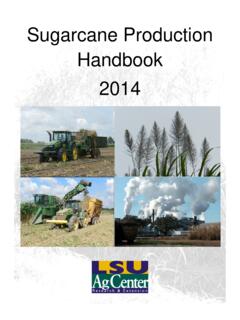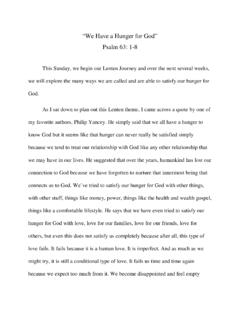Transcription of Home Orchard - LSU AgCenter
1 OrchardThe LouisianaHome LouisianaOrchardThe HomeLouisiana home fruit production appeals to many urban homeowners with limited space as well as to rural residents. home -grown vine or tree-ripened fruit is higher in quality than that bought at the grocery store. Growing your own fruit can be profitable and satisfying, and most fruit trees add to your cannot expect to grow quality fruit without caring for the plants. Success will depend largely on variety selection, soil management, pruning, fertilization, irriga-tion, pest control and other cultural size of your planting should be determined by the space available, site, size of your family and the time you can devote to Orchard a Good LocationThe success of the home fruit planting is influenced greatly by the site selected. This cannot be overemphasized. Remember: cold air, like water, flows downhill, so avoid low frost deep, well-drained soil with good surface and subsurface drainage is important.
2 Fruit plants will not grow well in water-logged soil. Also, the site should provide ample sunlight for proper growth and development of the the Right Kind of Fruit The decision to plant fruit should involve careful variety selection. Not all fruit species are adapted to all areas of Louisiana. To plant a given type or variety without considering its adaptation can lead to are often led to believe that many of the older, well-publicized varieties will do well in Louisiana home gardens. For example, the Bartlett pear and Elberta peach are two fruit varieties that have little place in a Louisiana fruit planting. The Elberta peach has been replaced by superior peach varieties, and the Bartlett pear is not adapted to our factors ultimately determine the adaptation of a given fruit species to an area. Some of these conditions are discussed RequirementMost fruit species not of the tropical type have a rest period. This is a stage of plant inactivity commonly associated with a loss of leaves or dormancy in winter.
3 Such plants will remain in this rest period until they receive a specific number of hours of cold below typically 45 degrees F. This is referred to as a chilling require-ment. The chilling requirement of a given variety of fruit is genetically controlled and is constant for that variety. When the rest period is satisfied, the plant awakens and becomes active with the warmth of spring. Some varieties may have rest periods of only 200 to 300 hours; others may have more than 1,000 hours. Pineapple pear, for example, because of its short rest period, will normally bloom with the first warm period of spring, often being injured by late cold weather. Other varieties with longer rest periods do not bloom until a month or so later. A plant that does not receive sufficient cold to satisfy its rest period requirements does not perform well. They are often delayed in both leafing out and blooming and will have a scattered bloom over a long period or blossoms may drop.
4 In extreme cas-es, unadapted plants will not live more than a season or two in areas of warm winter. Insect and Disease ResistanceMost homeowners are not adequately equipped to spray for control of insects and diseases. This problem can be minimized by selecting fruit types with few pest prob-lems or selecting varieties with resistance to known species may be grouped as high, medium or low maintenance crops relative to pest control needs:Low MaintenanceMedium MaintenanceHigh MaintenanceFruit TypesCitrus BlueberryFigPersimmonLoquatPears (some varieties)Muscadine GrapeBlackberryApplePeach & NectarinePlumStrawberryBunch GrapesMayhawIt is wise to select fruit types primarily from the low-maintenance category. Fruit, Variety, Area and Fertilizer RecommendationsFruitVarietyAreaSpacingRe marks(Fertilizer should not be placed within 9 of plant.)AppleOzark GoldN20 x25 Fertilize at 1 lb. 8-8-8/yr/tree age. Do not exceed 5 lbs per needs pollinizer.
5 Dorset Gold pollinates DeliciousN 20 x25 Red DeliciousN20 x25 Stayman WinesapN20 x25 Granny SmithN20 x25 GalaN20 x25 Molly DeliciousN & S20 x25 AnnaS20 x25 Dorset GoldS20 x25 BlueberryTifblueN & S6 x8 Apply fertilizer at 2 oz. 8-8-8/yr/tree age in February and after harvest. Do not exceed 1 1/2 lb/plant. Comparable rates of camellia/azalea fertilizer can be used. Ochlockonee and Alapaha are trial only, BlueN & S6 x8 ClimaxN & S6 x8 PremierN & S6 x8 BrightwellN & S6 x8 OchlockoneeN & S6 x8 AlapahaN & S6 x8 BramblesTrailing TypeBoysenberryN & S4 x6 Apply fertilizer at 1/2 lb 8-8-8/yr/tree age/10 ft of row in February and after harvest. Don t exceed 2 lbs/ft/row. Apply in 3 ft. wide band. Navaho and Ouachita late ripening. Arapaho early & S4 x6 Semi-erect TypeBrisonS3 x6 WomackN & S3 x6 BrazosN & S3 x6 CheyenneN & S3 x6 ShawneeN & S3 x6 RoseboroughN & S3 x6 Erect TypeKiowaN & S3 x6 Navaho (thornless)N2 x6 Arapaho (thornless)N & S2 x6 Apache (thornless)N2 x6 Ouachita (thornless)N & S2x6 RaspberriesDorman RedN & S4 x6 CitrusSatsumaArmstrong EarlyS15 x30 Fertilize at 1 1/2 lbs.
6 8-8-8/yr/tree age up to 12 yrs. Do not exceed 15 lbs per tree in x30 Louisiana Early S15 x30 KimbroughS15 x30 Early St AnneS15 x30 Brown s SelectS15 x30 FruitVarietyAreaSpacingRemarks(Fertilize r should not be placed within 9 of plant.)Citrus (continued)Sweet OrangeHamlin SweetS15 x30 Apply fertilizer at 1 1/2 lb. 8-8-8 age in late January-early February. Do not exceed 18 lbs. per tree. Kumquat is a sweet SweetS15 x30 AmbersweetS15 x30 Moro Blood S15 x30 PlaqueminesS15 x30 Pineapple SweetS15 x30 ValenciaS15 x30 NavelWashingtonS15 x25 GrapefruitDuncanS15 x30 Rio RedS15 x30 Ruby RedS15 x30 TangeloOrlandoS15 x25 MandarinPonkanS15 x25 LemonMeyerS15 x25 TangerineDancyS15 x25 RobinsonS15 x25 SunburstS15 x25 OrlandoS15 x25 KumquatNagami S10 x15 MeiwaS10 x15 FigLSU PurpleN & S15 x25 Apply fertilizer at 1/2 lb. of 8-8-8/yr/plant age. Do not exceed 7 lbs. per Rourke, Champagne, and Tiger are new LSU GoldN & S15 x25 CelesteN & S15 x20 O Rourke (Tested as Improved Celeste) N & S15 x20 Champagne (Tested as Golden Celeste) N & S15 x20 Southeastern Brown TurkeyN & S15 x20 Alma S & N15 x20 Tiger (Tested as Giant Celeste)N & S15 x20 FruitVarietyAreaSpacingRemarks(Fertilize r should not be placed within 9 of plant.)
7 GrapeBunchFredoniaN10 x12 Apply fertilizer at 1/2 lb. 8-8-8/yr/plant age. Do not exceed 2 1/2 *Pierce s Disease resistant LakeS10 x12 Conquistador*S 10 x12 NiagaraN10 x12 DelawareN10 x12 Miss BlancN & S10 x12 Miss BlueN & S10 x12 Mid SouthN & S10 x12 Suwanee*N & S10 x12 MayhawRed MajestyN & S20 x25 Apply fertilizer at 1/4 to 1/2 lb. 8-8-8/yr/tree age. All varieties fire blight and quince rust susceptible. Maximum of 3 lbs. 8-8-8 per & S20 x25 Texas Star ( G-1)N & S20 x25 Royal Star (G-5)N & S20 x25 Spectacular (G-2)N & S20 x25 Texas Super Berry S20 x25 MuscadineSelf-unfruitfulScuppernongN & S20 x12 Apply fertilizer at 1/2 lb. 8-8-8/yr/tree age. Self-unfruitful varieties require a self-fruitful variety near them to provide pollen. Maximum of 4 lbs. per plant per GateN & S20 x12 SupremeN & S20 x12 DarleneN & S20 x12 HuntN & S20 x12 TopsailN & S20 x12 HigginsN & S20 x12 Sweet JennyN & S20 x12 Black FryN & S20 x12 FryN & S20 x12 FarrerN & S20 x12 MuscadineSelf-fruitfulCarlosN & S20 x12 CowartN & S20 x12 NesbitN & S20 x12 Granny ValN & S20 x12 TaraN & S20 x12 IsonN & S20 x12 LoquatSeedlingsS15 x20 Apply fertilizer at 1/2 to 1 lb/yr/tree age up to 10 yrs.
8 Do not exceed 5 lbs. per JimS15 x20 NectarineOvationN20 x25 Apply fertilizer at 1 lb/yr/tree age. Do not exceed 8 lbs. per tree. Three split applications in February, April and August after x25 Karla RoseN20 x25 SunredS20 x25 FruitVarietyAreaSpacingRemarks(Fertilize r should not be placed within 9 of plant.)PeachNorth La. (Latitude above Alexandria)RegalN20 x25 Apply fertilizer at 1 lb. 8-8-8/yr/tree age. Do not exceed 8 lbs. per tree. Three split applications in February, April and August after x25 SurecropN20 x25 GalaN20 x25 HarvesterN20 x25 WildroseN20 x25 MajesticN20 x25 RedglobeN20 x25 LoringN20 x25 LaPremierN20 x25 Ruston RedN20 x25 DixilandN20 x25 Ouachita GoldN20 x25 Flame PrinceN20 x25 Mid-South Louisiana (Latitude between Alexandria and Baton Rouge)RegalS20 x25 DeltaS20 x25 Gold PrinceS20 x25 LaSweetS20 x25 HarvesterS20 x25 LaGoldS20 x25 HawthorneS20 x25 LaFelicianaS20 x25 LaRougeS20 x25 LaBelleS20 x25 DixilandS20 x25 South La.
9 (Latitude below Baton Rouge.)Florida KingS20 x25 LaFestivalS20 x25 Florida GoldS20 x25 Coastal area of La. (Southern-most parishes only).Florida KingS20 x25 Gulf CrestS20 x25 Gulf PrinceS20 x25 DeltaS20 x25 Gulf KingS20 x25 Sam HoustonS20 x25 Florida PrinceS20 x25 Earli GrandeS20 x25 TexstarS20 x25 Sun GrandeS20 x25 FruitVarietyAreaSpacingRemarks(Fertilize r should not be placed within 9 of plant.)PearBaldwinN & S20 X25 Apply fertilizer at 1/2 lb. 8-8-8/yr/tree age. Do not exceed 4 lbs. per & S20 X25 OrientN & S20 X25 MaxineN20 X25 MoonglowN20 X25 AyersN20 X25 Japanese PersimmonTanenashiN & S20 x25 Apply fertilizer at 1/2 lb. 8-8-8/yr/tree age. Do not exceed 5 lbs. per & S20 x25 Fuyu (non-astringent)N & S20 x25 Fuyu Imoto (non-astringent)N & S20 x25 Hana Fuyu (non-astringent)N & S20 x25 Suruga (non-astringent) N & S20 x25 Pineapple Guava (Feijoa)SeedlingsN & S15 x15 Apply fertilizer at 1 lb. 8-8-8/yr/tree age. Do not exceed 5 lbs. per & S15 x15 TriumpN & S15 x15 PlumMorrisN20 X20 Apply fertilizer at 1 lb.
10 8-8-8/yr/tree age. Do not exceed 8 lbs. per and Au-Rubrum are & S20 X20 Ozark PremierN20 X20 Byron GoldN & S20 X20 ExplorerN20 X20 MethleyN20 X20 Au-RubrumN 20 X20 StrawberryChandler N & S1 apart on 42 rowsApply fertilizer 6 deep under plants 2 weeks prior to FestivalN & S1 apart on 42 rowsCamarosaN & S1 apart on 42 rowsEarliglowN & S1 apart on 42 rowsUse in matted row culture 0 Figure 1. Heel in nursery stock if you cannot plant Good Nursery StockObtain the best nursery stocks available. Buy only from reputable nurseries that guarantee plants to be true to name, of high quality, and packed and shipped properly. Beware of bargains. A common mistake is to select and purchase oversized ready-to-bear nursery trees. Experience has shown that young trees bear fruit almost as soon, are easier to transplant and develop into healthier, more vigorous trees than do oversized stock. The older trees cost nurseries more to grow, are sold at higher prices, but are usually worth less.
















